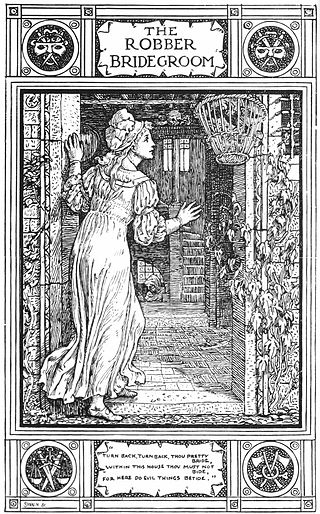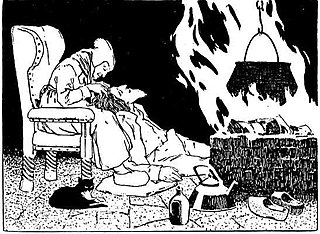
A fairy tale is a short story that belongs to the folklore genre. Such stories typically feature magic, enchantments, and mythical or fanciful beings. In most cultures, there is no clear line separating myth from folk or fairy tale; all these together form the literature of preliterate societies. Fairy tales may be distinguished from other folk narratives such as legends and explicit moral tales, including beast fables. Prevalent elements include dragons, dwarfs, elves, fairies, giants, gnomes, goblins, griffins, merfolk, monsters, talking animals, trolls, unicorns, witches, wizards, magic, and enchantments.

"Hansel and Gretel" is a German fairy tale collected by the Brothers Grimm and published in 1812 as part of Grimms' Fairy Tales. It is also known as Little Step Brother and Little Step Sister.

A gingerbread man is a biscuit or cookie made from gingerbread, usually in the shape of a stylized human being, although other shapes, especially seasonal themes and characters are common too.

Boxty is a traditional Irish potato pancake. The dish is mostly associated with the north midlands, north Connacht and southern Ulster, in particular the counties of Leitrim, Mayo, Sligo, Fermanagh, Longford, and Cavan. There are many recipes but all contain finely grated, raw potatoes and all are served fried.
The Aarne–Thompson–Uther Index is a catalogue of folktale types used in folklore studies. The ATU Index is the product of a series of revisions and expansions by an international group of scholars: originally composed in German by Finnish folklorist Antti Aarne (1910), the index was translated into English, revised, and expanded by American folklorist Stith Thompson, and later further revised and expanded by German folklorist Hans-Jörg Uther (2004). The ATU Index, along with Thompson's Motif-Index of Folk-Literature (1932)—with which it is used in tandem—is an essential tool for folklorists.

"The Juniper Tree" is a German fairy tale published in Low German by the Brothers Grimm in Grimm's Fairy Tales in 1812. The story contains themes of child abuse, murder, cannibalism and biblical symbolism and is one of the Brothers Grimm's darker and more mature fairy tales.

"The Robber Bridegroom" is a German fairy tale collected by the Brothers Grimm, tale number 40. Joseph Jacobs included a variant, Mr Fox, in English Fairy Tales, but the original provenance is much older; Shakespeare alludes to the Mr. Fox variant in Much Ado About Nothing, Act 1, Scene 1:

"The Devil with the Three Golden Hairs" is a German fairy tale collected by the Brothers Grimm. It falls under Aarne–Thompson classification types 461, and 930.
The Dirty Shepherdess is a French fairy tale collected by Paul Sébillot. Andrew Lang included it in The Green Fairy Book.
A gingerbread man is a biscuit or cookie made of gingerbread, in human shape.
The Little Bull-Calf is an English Romani fairy tale collected by Joseph Jacobs in More English Fairy Tales.
Jack and his Comrades is a short Irish fairy tale describing the title character's story of success with the help of his animal helpers, collected by folklorist Patrick Kennedy from a resident of County Wexford, Ireland, and published in Legendary Fictions of the Irish Celts (1866). It was later reprinted, revised but only slightly, by Joseph Jacobs in his Celtic fairy tale compilation.
John Dough and the Cherub is a children's fantasy novel, written by American author L. Frank Baum, about a living gingerbread man and his adventures. It was illustrated by John R. Neill and published in 1906 by the Reilly & Britton Company. The story was serialized in the Washington Sunday Star and other newspapers from October to December 1906. Like the Oz books but unlike many of the author's other works, John Dough was issued under Baum's name rather than one of his pseudonyms. The book was popular; as late as 1919 it was selling 1500 copies a year. The 1974 Dover Publications edition features an introduction by Martin Gardner.

Little Wildrose is a Romanian fairy tale. Andrew Lang included it in The Crimson Fairy Book.

Kolobok is the main character of an East Slavic fairy-tale with the same name, represented as a small yellow spherical bread-like being. The story is often called "Little Round Bun" and sometimes "The Runaway Bun."

John Dough was a common name for a gingerbread man at the turn of the 20th century, though the best-remembered John Dough is the character created by L. Frank Baum in his 1906 novel, John Dough and the Cherub; the character also makes a cameo appearance in Baum's The Road to Oz. If the fragment known as "An Oz Book" is genuine, Baum may have intended to include John Dough in his fifteenth Oz book had he lived to write it.

In a cumulative tale, sometimes also called a chain tale, action or dialogue repeats and builds up in some way as the tale progresses. With only the sparest of plots, these tales often depend upon repetition and rhythm for their effect, and can require a skilled storyteller to negotiate their tongue-twisting repetitions in performance. The climax is sometimes abrupt and sobering as in "The Gingerbread Man." The device often takes the form of a cumulative song or nursery rhyme. Many cumulative tales feature a series of animals or forces of nature each more powerful than the last.
The Pedlar of Swaffham is an English folktale from Swaffham, Norfolk. The following text is taken from English Fairy and Other Folk Tales, 1906, which in turn refers to the Diary of Abraham dela Pryme, 1699:
The Princess in the Suit of Leather is an Egyptian folktale. It may also be referred to as The Princess in the Leather Burqa. This story was originally published in translation in Inea Bushnaq's 1986 collection Arab Folktales. Author Angela Carter included it in The Old Wives’ Fairy Tale Book.
The Fire Boy is a Japanese folktale collected by scholar Seki Keigo. It tells of a boy expelled from home to another realm and, thanks to the efforts of a faithful horse, marries a lord's daughter.











